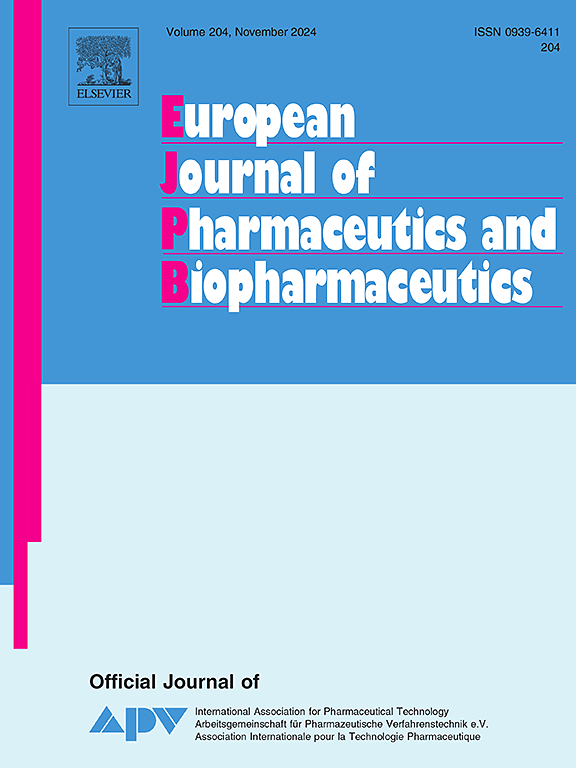Green synthesis of gold nano-particles using Madhuca indica flower extract and their anticancer activity on head and neck cancer: Characterization and mechanistic study
IF 4.4
2区 医学
Q1 PHARMACOLOGY & PHARMACY
European Journal of Pharmaceutics and Biopharmaceutics
Pub Date : 2025-02-01
DOI:10.1016/j.ejpb.2025.114625
引用次数: 0
Abstract
Complete eradication of aggressive head and neck squamous cell carcinoma (HNSCC) still remains a major challenging problem due to numerous resistance properties of cancer stem cells (CSC) which is crucially responsible for tumor recurrence and metastasis. This challenge causes a high demand for the emergence of novel targeted treatment modalities for improved therapeutic efficacies. Phytochemicals derived from plants proves to be a wide reservoir of important drug candidates which have the potential to impede multiple aspects of malignant growth and progression.
In the present study, we aimed to synthesize gold nanoparticles in a rapid and cost-effective manner by utilizing Madhuca indica flower extract and to evaluate its anticancer efficacy on head and neck cancer model via targeting cancer stemness and EMT.
The phytochemicals present in the Madhuca indica flower extract acted as an effective reducing agent helping in the green synthesis of gold nanoparticles. The generated AuNPs were characterized by UV–Vis spectroscopy, XRD, FTIR, TEM, FE-SEM, DLS, EDX. Anti cancer potential of synthesized AuNPs were evaluated by in vitro and ex vivo HNSCC model. In vivo toxicity was assessed in Swiss albino mice model.
The gold nanoparticles were characterized using UV–Vis spectroscopy which revealed unique wavelength maxima at 550 nm and its crystalline nature was confirmed by XRD. AuNPs were observed to be spherical in shape with the mean diameter of 20.34 ± 4.36 nm and zeta potential of nearly −50 mV. The FTIR spectral shift indicated the incorporation of various functional groups. MI-AuNP depicted strong anticancer attributes against HNSCC cell lines SCC154 and FaDu through significant inhibition of cancer stemness and EMT as evident from decreased tumor sphere forming efficiency and CD44+/CD24- subpopulation along with dose dependent downregulated expression of relevant CSC markers and EMT markers both in vitro and ex vivo HNSCC model. Additionally, no evidence of in vivo toxicity has been observed with MI-AuNP administration.
In conclusion, this study reported for the first time that the MI-AuNP synthesized by novel green chemistry can efficiently prevent the self-renewal capability of HNSCC by targeting Cancer stemness. The scientific significance of this study lies in the fact that MI-AuNP might be a novel and potential therapeutic candidate against aggressive and metastatic HNSCC. The findings in this study unravels the way for developing a novel therapeutic candidate against aggressive and metastatic HNSCC with a much higher prognostic potential and significantly reduced off target toxicity.

madhaha indica花提取物绿色合成纳米金颗粒及其对头颈部肿瘤的抗癌作用:表征及机制研究。
完全根除侵袭性头颈部鳞状细胞癌(HNSCC)仍然是一个主要的挑战性问题,因为癌症干细胞(CSC)的许多耐药特性是肿瘤复发和转移的关键原因。这一挑战引起了对新型靶向治疗方式的高度需求,以提高治疗效果。从植物中提取的植物化学物质被证明是一个广泛的重要候选药物库,具有阻止恶性肿瘤生长和进展的多个方面的潜力。本研究旨在以麻花提取物为原料,快速、经济地合成金纳米颗粒,并通过靶向肿瘤干性和EMT评价其对头颈部肿瘤模型的抗癌效果。中花提取物中的植物化学物质是一种有效的还原剂,有助于金纳米颗粒的绿色合成。通过紫外可见光谱、XRD、FTIR、TEM、FE-SEM、DLS、EDX等手段对合成的AuNPs进行了表征。通过体外和离体HNSCC模型评价合成的AuNPs的抗癌潜力。在瑞士白化病小鼠模型中评估体内毒性。利用紫外可见光谱对纳米金进行了表征,发现其最大波长为550 nm,并通过XRD对其晶体性质进行了表征。AuNPs呈球形,平均直径为20.34 ± 4.36 nm, zeta电位接近-50 mV。FTIR光谱位移表明掺杂了多种官能团。MI-AuNP对HNSCC细胞系SCC154和FaDu具有很强的抗癌特性,通过显著抑制肿瘤干细胞性和EMT,这从肿瘤球形成效率和CD44+/CD24-亚群的降低以及相关CSC标志物和EMT标志物在体外和离体HNSCC模型中的剂量依赖性下调表达可以看出。此外,未观察到MI-AuNP给药的体内毒性证据。综上所述,本研究首次报道了新型绿色化学合成的MI-AuNP可以通过靶向肿瘤干细胞有效地阻止HNSCC的自我更新能力。这项研究的科学意义在于,MI-AuNP可能是一种新的、潜在的治疗侵袭性和转移性HNSCC的候选药物。这项研究的发现为开发一种新的治疗候选药物来治疗侵袭性和转移性HNSCC开辟了道路,这种药物具有更高的预后潜力,并显著降低了脱靶毒性。
本文章由计算机程序翻译,如有差异,请以英文原文为准。
求助全文
约1分钟内获得全文
求助全文
来源期刊
CiteScore
8.80
自引率
4.10%
发文量
211
审稿时长
36 days
期刊介绍:
The European Journal of Pharmaceutics and Biopharmaceutics provides a medium for the publication of novel, innovative and hypothesis-driven research from the areas of Pharmaceutics and Biopharmaceutics.
Topics covered include for example:
Design and development of drug delivery systems for pharmaceuticals and biopharmaceuticals (small molecules, proteins, nucleic acids)
Aspects of manufacturing process design
Biomedical aspects of drug product design
Strategies and formulations for controlled drug transport across biological barriers
Physicochemical aspects of drug product development
Novel excipients for drug product design
Drug delivery and controlled release systems for systemic and local applications
Nanomaterials for therapeutic and diagnostic purposes
Advanced therapy medicinal products
Medical devices supporting a distinct pharmacological effect.

 求助内容:
求助内容: 应助结果提醒方式:
应助结果提醒方式:


